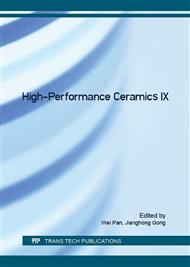p.23
p.27
p.33
p.39
p.44
p.49
p.54
p.58
p.62
Preparation of Zirconium Diboride Powder by Carbon Thermal Reduction Method
Abstract:
Zirconium diboride (ZrB2) powders with no impurities were prepared using zirconium oxide (ZrO2), boron carbide (B4C) and carbon black as raw material by carbon thermal reduction. The phase composition of ZrB2 powders was characterized by X-ray diffraction (XRD) and the micro-morphology was observed by scanning electron microscope (SEM). The effects of B4C content, calcination temperature and holding time were studied on the formation of ZrB2 powders. The results indicated that ZrB2 powders could be successfully synthesized while holding for 1.5 h at 1600 °C in Ar atmosphere. When the content of B4C was 17.7 wt% , there existed the crystal phase of ZrB2 only. The impurities could be easily led in with the increase of content of B4C. ZrB2 powders with the size from 1-5 μm could be obtained eventually and the particle size grew obviously with increase of the holding time.
Info:
Periodical:
Pages:
44-48
Citation:
Online since:
July 2016
Authors:
Keywords:
Price:
Сopyright:
© 2016 Trans Tech Publications Ltd. All Rights Reserved
Share:
Citation:


